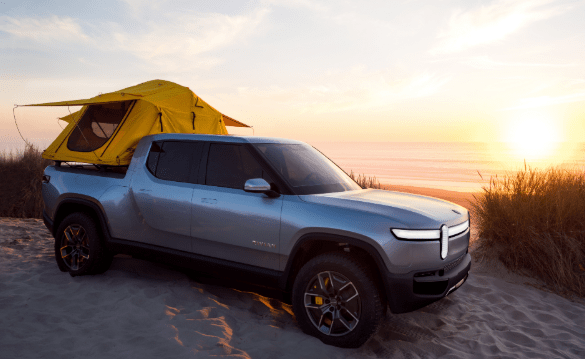
Why Is There No Self-Driving Pickup Truck Prototype?
Regardless of if the marketing term is ‘self-driving’ or ‘autonomous’, the truth is that no current vehicle can operate on its own. Despite their regular appearance in news articles, cars that can drive themselves aren’t coming anytime soon. But there’s something interesting about the types of vehicles being tested. Tech companies and automakers trial passenger sedans, minivans, and even semi-trucks. But why isn’t there a self-driving pickup?
Potential Self-Driving Pickup Producers
At the moment, the automaker closest to offering anything close to a self-driving pickup is Tesla. The EV company’s Autopilot is by no means true autonomy, and the pickup model is still under wraps, but it’s still the closest. Tesla also offers Smart Summon. Although it still requires a human controller and has a host of issues, it is the only company with such a feature. Neither Rivian or Ford, Tesla’s competitors in the electric pickup market, have an answer. However, Rivian’s R1T does offer a clue as to the lack of self-driving pickups. But we’ll get back to that.

It’s not like other automakers with pickup models haven’t been pursuing advanced driver-assistance features (which is what Tesla’s Autopilot really is). Waymo, for instance, tests with Chrysler Pacifica minivans. FCA has a whole pickup division, Ram, but Waymo hasn’t used their models for trials. Cadillac has its Super CruiseTM system, but it hasn’t spread across the rest of GM’s lineup yet. Mercedes-Benz doesn’t offer its X-Class pickup here, but the company has some impressive driverless tech. The same goes for Nissan’s ProPilot AssistTM—no word was given about it in the Frontier’s recently-announced update.
What’s even more glaring is that it’s not like size is a factor.
State of Tech
‘Self-driving’ cars use a blend of technologies to see the world around them. Radar, already used in adaptive cruise control, measures an object’s speed and direction. Cameras look at and ID things like signs, road markings, and cyclists (not always successfully). GPS, as Jason Torchinsky notes in his book on autonomous cars, Robot Take the Wheel, although only accurate to “between about three and ten feet”, can still be used to “plan ahead”, and report location in the case of an accident. Ultrasonic sensors, used in Tesla’s Autopilot, allow more precision at close-range, which is why they’re also used as parking sensors. Finally, there’s LIDAR. Elon Musk famously doesn’t like it, but LIDAR (think ‘light-based radar’) can map surroundings in high-detail very quickly.
Not every single driver-assistance system (aka ‘self-driving suite’) uses every single option. Tesla doesn’t use LIDAR, for instance, but almost every other manufacturer does. But this technology isn’t only limited to passenger cars.
Self-Driving Semi-Trucks
Waymo doesn’t just use vans. They also have a truck division. And Waymo Truck, as Jalopnik has covered, has been testing its self-driving semi-truck since 2017. The semi-truck uses LIDAR, radar, and multiple high-resolution cameras to differentiate between objects on the road. In fact, the semi-truck uses multiple kinds of LIDAR and radar systems to track objects and speed in three dimensions.
So, if a semi-truck can be used to develop autonomous tech, why not a pickup? True, some of the sensors, especially LIDAR, are still a bit bulky. But that doesn’t matter as much on a pickup truck, especially some of the larger heavy-duty ones, as it does on sedans. Arguably, being bigger and taller is actually better, in this case. A taller vehicle provides better coverage and visibility for the sensors and cameras. A larger vehicle may have more area for the sensors to cover, but it also provides more area to place sensors on. The more data, the better the picture the onboard computers can paint.
The limiting factor isn’t technology. It’s actually something that’s inherent to the pickup itself.
Self-Driving Pickup: Utility vs. Adventure
One of the most attractive aspects of the pickup is that it can more or less do it all. Utilitarian tool hauler, people mover, and off-road explorer. But that becomes a problem when autonomy is proposed.
If the focus is moving people, pickups fall behind. Minivans and small buses like Local Motors’ Olli have the same footprint, but fit more people. Enclosing the pickup bed just leaves a van.

If the goal is moving cargo, why include a cabin? Volvo’s autonomous semi-truck, Vera, doesn’t have room for a person inside. Neither does Einride’s T-pod, the Scania AXL concept, or the autonomous trucks seen in the movie Logan that resemble rolling shipping containers.
To paraphrase Torchinsky’s book, self-driving vehicles are essentially robots, built for a specific purpose. If the end-goal is hauling stuff, you can haul more stuff if you take out all the safety features and seats for people. Jason Torchinsky even sketches a design for an autonomous truck that apes those seen in Logan.

Finally, to return to Rivian. Nowhere in their information or marketing for the R1T do they talk about autonomy or self-driving. But what the company does stress is a sense of adventure and exploration. A recent Audi off-road concept, the AI:TRAIL, riffs on the same idea. Audi’s AI: TRAIL would offer the ability to drive itself—until it got to the off-roading part. Audi won’t map the outdoors, because the whole point is to go explore it for yourself. Sure, you’ll have a drone or onboard cameras to help guide you, but you’ll still have your self-agency.
A self-driving pickup probably won’t happen. Not because we can’t make one, but because there’s no point.


